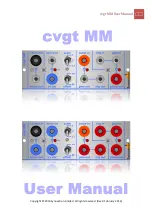
Program P7: KARMA 7–4: Module Parameters-Trigger
109
Note
Note Trigger
[Any, AKR, 1st, Dyn]
Any (Any Note + Dynamic MIDI):
Every note-on will
cause triggering; i.e., each note-on will cause the
phrase or pattern to restart from the beginning.
AKR (1st Note After Key R Dynamic MIDI):
Triggering will occur when the first note-on occurs
from a state in which no keys are “on.” Triggering will
not occur if even one note is being pressed. By
changing the chord you play on the keyboard while
holding at least one note, you can change the notes of
the phrase or pattern without triggering.
1st (1st Only Until Module Stops + Dynamic MIDI):
After KARMA function is turned on, only the first
note-on will cause triggering. Subsequent note-ons will
not cause triggering.
This is useful for drum grooves and phrases where you
do not want subsequent chord changes to restart the
phrase.
Dyn (Dynamic MIDI):
Triggering will be produced by
operating the controller specified by Dynamic MIDI
(Program 7–7). In this case, note-ons will not cause
triggering.
Note: With any of these settings, the trigger will be
applied by operations of the controller specified for
Dynamic MIDI (Program 7–7), if “Destination” is set to
Trigger Notes&Envs
,
Trigger Note
MIDI Sources & Destinations” on page 984).
Note Latch
[Off, On]
Specifies whether the phrase or pattern will continue
when you release your hand from the keyboard (
latch
on
) or whether the phrase or pattern will stop (
latch
off
). In Program mode, turn this
On (checked)
and use
the LATCH switch to control latch on/off.
Off (unchecked):
Latch will be off regardless of the
LATCH switch on/off status.
On (checked):
The LATCH switch will control latch
on/off.
When the LATCH switch is
off
(LED dark),
latch is off
.
When the LATCH switch is
on
(LED lit),
latch is on
.
Note: In Combination and Sequencer mode, up to four
KARMA Modules can be used. In these modes, you
can turn “Note Latch” on/off independently for each
KARMA Module. If you use “Copy KARMA Module”
to copy KARMA Module settings from these modes to
a program, there may be cases in which the setting here
will be
off
, so that latch-on will not occur even if you
turn
on
the LATCH switch. In such cases, turn this
on
.
Envelope1, Envelope2, Envelope3
Each GE provides three Envelopes. They can produce
time-variant control of velocity, tempo, duration, pitch
bend, and various control changes.
You can specify triggering conditions and latch
conditions for each of the three Envelopes of the GE,
separately from the Note Trigger and Latch (although
many times you will want them to be the same.)
If the selected GE does not use Envelopes, these
settings will have no effect. For information on
specific GEs, please see the “Voice Name List” on
page 1041.
Envelope Trigger
[Any, AKR, 1st, Dyn]
Any (Any Note + Dynamic MIDI):
Every note-on will
cause triggering; i.e., each note-on will cause the
envelope to start from the beginning.
AKR (1st Note After Key R Dynamic MIDI):
Triggering will occur when the first note-on occurs
from a state in which no keys are “on.” Retriggering
will not occur if even one note is being pressed.
1st (1st Only Until Module Stops + Dynamic MIDI):
After KARMA is turned on, only the first note-on will
cause triggering. Subsequent note-ons will not cause
triggering.
Dyn (Dynamic MIDI):
Triggering will be produced by
operating the controller specified by Dynamic MIDI
(Program 7–7). In this case, note-ons will not cause
triggering.
Note: For any of these settings, triggering will be
applied by operations of the controller specified for
Dynamic MIDI, if “Destination” is set to
Trigger
Notes&Envs
,
Trigger Env1…Trigger Env3
.
Envelope Latch
[Off, Sus1, Rel1, Sus2, Rel2]
Off:
The envelope will not be latched. When all keys
are released or a Dynamic MIDI trigger is released
(note-off), the envelope will move to the release
segment.
Sus1:
Once the envelope is started, it will proceed
through attack
→
decay
→
sustain
→
release. If note-
off occurs before the envelope reaches the sustain level,
the envelope will not begin the release immediately
but wait until after reaching the sustain level. Even in
the case of a note for which the note-on/off interval is
short, the envelope will proceed through attack
→
decay
→
sustain
→
release as if the key was being held
for a longer time. If the envelope reaches the sustain
level before receiving note-off, it will hold at the
sustain level (the same operation as for the Off setting).
If the note-off occurs after the envelope reaches the
sustain level, the envelope will begin the release when
note-off occurs (the same operation as for the Off
setting).
Rel1:
Once the envelope has started, it will proceed
through attack
→
decay
→
release, regardless of when
the note-off occurs. Even if a key is being pressed, the
envelope will ignore sustain, and will proceed
immediately to the release.
Sus2:
The envelope will ignore note-off, and will
proceed through attach
→
decay
→
sustain. Therefore,
this setting will never reach the release portion. Other
operation is the same as for
Sus1
.
Rel2:
The same operation as
Rel1
, except will ignore
note-off for the purpose of looping, as explained below.
The envelope can be set to repeat as a loop as part of
the GE. A looped envelope will be controlled as
follows.
For Sus1 and Rel1,
the envelope will continue
repeating as long as the key is held.
Summary of Contents for Electronic Keyboard
Page 1: ...Parameter Guide Parameter Guide ...
Page 2: ......
Page 180: ...Program mode EXi 170 ...
Page 290: ...EXi STR 1 Plucked String 280 ...
Page 572: ...Sequencer mode 562 ...
Page 700: ...Global mode 690 ...
Page 751: ...Insert Effects IFX1 IFX12 Routing 741 Fig 2 3a Fig 2 3b ...
Page 902: ...Effect Guide 892 ...
















































